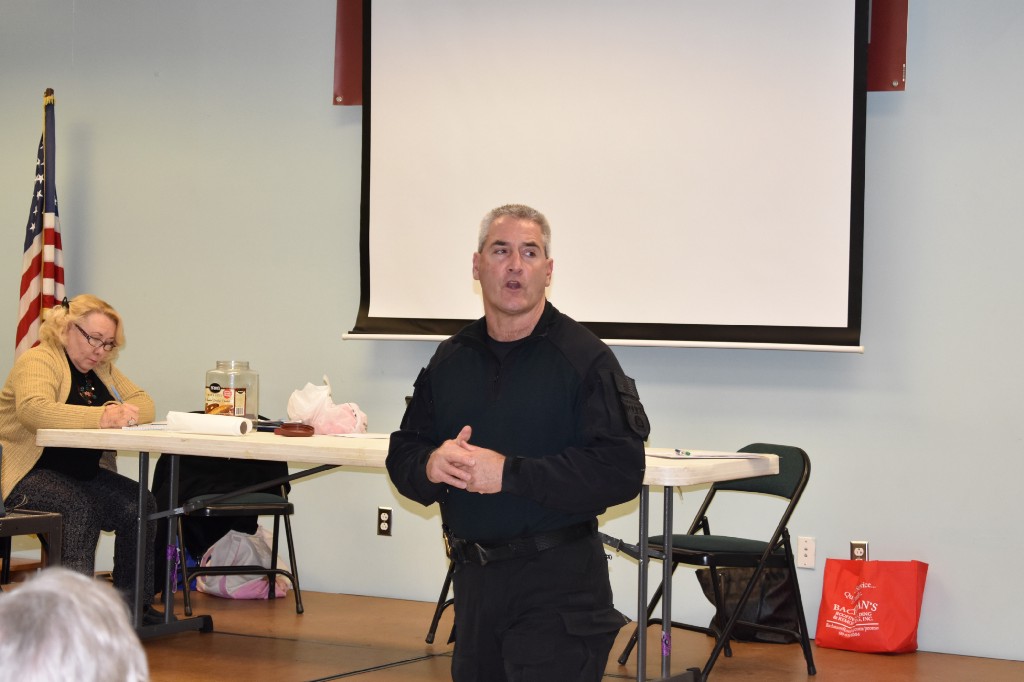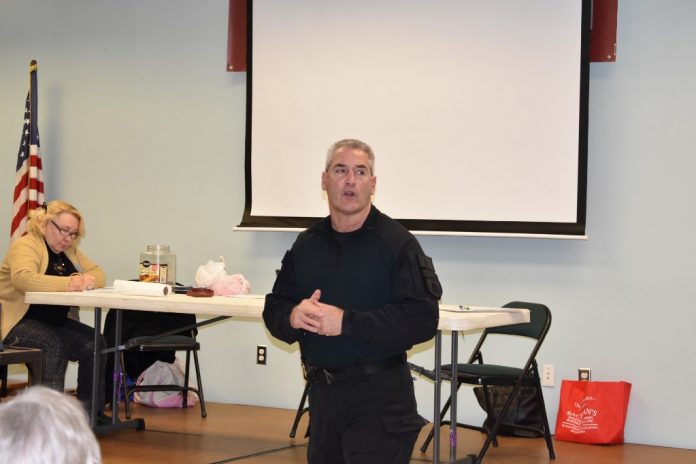Detective Joseph Rovnan of Counter Terrorism Operations recently gave a presentation about what to do in the event of an active shooting.

By Jan. 23, there had been 11 school shootings in the country just this year.
On the morning of Wednesday, Jan. 24, Parkway Northwest High School in Germantown underwent lockdown after reports two students had brought weapons to the school. Two students were taken into custody. Luckily, no one was injured.
On that same day, Detective Joseph Rovnan of Counter Terrorism Operations visited the Holme Circle Civic Association to give a presentation on what to do in an active shooting situation. It was the seventh presentation he had given that day on the subject.
“How many of you have gotten in the habit of knowing two ways out of everywhere you go?” he asked the crowd of a few dozen people in the St. Jerome’s School Hall basement. Only a few raised their hand.
“You get on a plane and they point out the exit to you,” he said. “Why don’t we practice the same thought process down here?”
Rovnan has served on the Philadelphia Police Department for 27 years, and has trained people for active shooting situations for five.
“[Police] response might not be as quick as you think we can get there,” he said, citing a list of factors that could prevent police from immediately reporting to a situation, including weather and distance.
The average active shooting incident lasts 10 to 12 minutes. Out of 200 incidents studied, 69 percent of them were finished in five minutes.
“As much as I want to get there and protect you, you have to know what would you do in five minutes,” he said.
Rovnan boiled down existing courses of action to three possibilities — running, hiding or fighting.
“Police want you to run,” Rovnan said. But that isn’t always an option.
Depending on where the shooter is, hiding may be the better option. As an example, Rovnan mentioned that if the shooter were to remain in the exit of a school and pulls the fire alarm, it could act as a lure to get people to run toward them.
Rovnan said to hide behind doors that can swing inward rather than outward so that they can be barricaded from the inside. He also said to stay put until police clear the area and find you.
“You will have no holes in you if you stay in your hiding spot until police find you,” he said.
In hiding spots, stay away from glass, silence phones and be as silent as possible, and do not huddle together.
In the worst situation where fighting is necessary, Rovnan said to be aggressive.
“The shooter continues until they are stopped,” he said. “Be aggressive, scream, yell.”
Ninety percent of shooters are suicidal, which means they will act with no regard for their safety. Shooters will normally have intended targets, but will harm anyone they come across (Rovnan referred to these victims as targets of opportunity). This means shooters won’t stop until they reach their intended target or they are injured or killed.
However, some shootings are spontaneous. There is no profile for a shooter, but there are behaviors and signs they have in common. These signs can include (but are not limited to) the person being less talkative, depressed, talking about guns or violence, overreaction to workplace changes and increased use of alcohol or drugs.
Rovnan stressed the importance of awareness in all situations.
“There’s no second guessing in these situations,” he said.
Having an escape plan and knowing where stairs, fire escapes and emergency doors are located is something anyone can do at a workplace or any public building. When fleeing, drop all possessions and leave empty-handed — Rovnan said police keep an eye on hands to see if there are weapons.
He recommended calling 911 if possible and talking to them if it is safe to do so or leaving them on the phone so they can gain intelligence about the situation. He also said it’s possible to text 911 — if you do, send just the location and situation as quickly as possible.
When describing the shooter, don’t start with clothes — Rovnan said it is easy for shooters to change their clothing. Describe hair, height, weight and any other notable physical characteristics of the person.
The Holme Circle Civic Association always meets on the fourth Wednesday of the month. ••
Logan Krum can be reached at [email protected]





